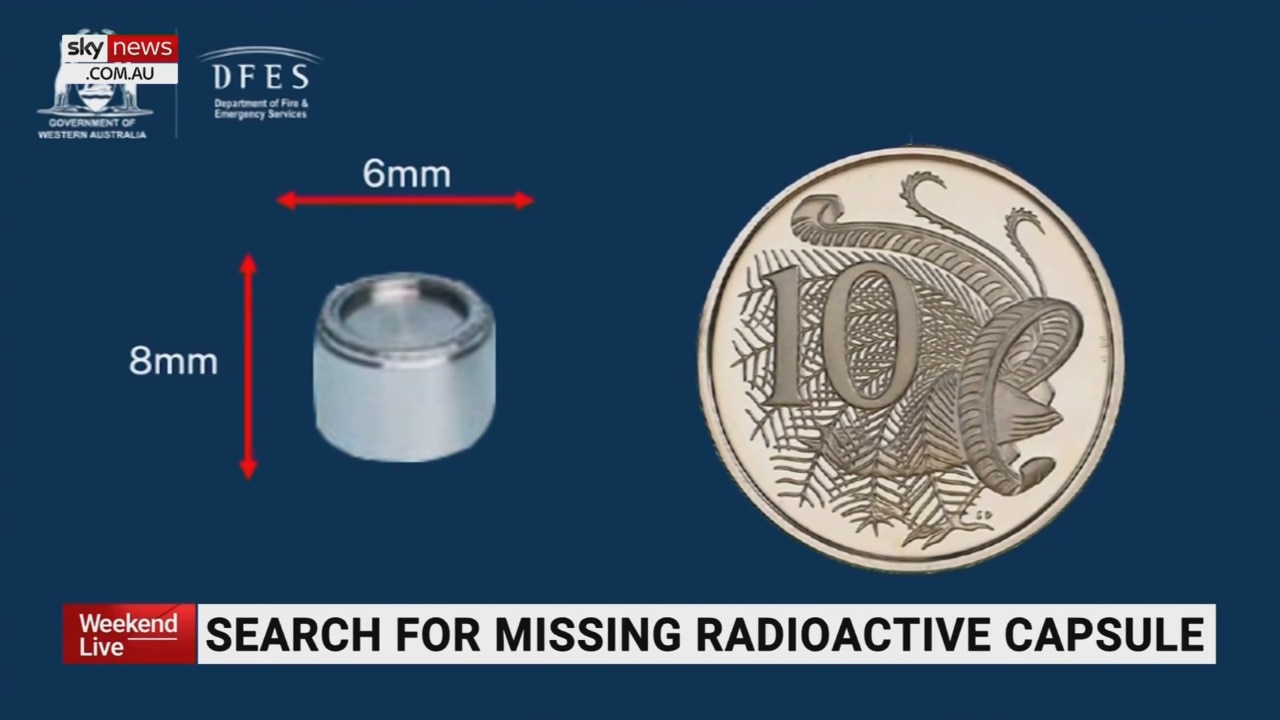Lost, deadly radioactive capsule smaller than 10c coin
A frantic search is under way for a deadly radioactive capsule lost somewhere in the WA bush. The catch? It’s smaller than a 10c coin.

A frantic search is under way for a tiny, potentially deadly radioactive capsule lost somewhere in a huge expanse of West Australian bush.
The catch — the highly dangerous capsule is smaller than a 10c piece.
It was lost by a tradie, who was contracted by the Rio Tinto Mining Company, somewhere on a 1300-kilometre stretch of road in outback WA, and has been missing for up to 21 days.
Measuring just 6mm by 8mm, the tiny capsule came loose at some point during its transportation from north of the Pilbara mining town of Newman, to the Perth suburb of Malaga.
Officials say its unclear when the capsule went missing, but it could have been any time between January 10 and January 16.
Given it is highly dangerous, a frantic search is under way — though authorities admit it may never be found.

How dangerous is it?
The small, round, silver capsule is used within gauges in mining operations, and contains a small but extremely dangerous quantity of radioactive Caesium-137.
It releases radiation equivalent to receiving about 10 X-rays every hour — or about the amount of natural radiation a human would usually receive in an entire year.
Close contact with the capsule would likely cause serious illness and even death, according to WA Deputy Premier Roger Cook.
“My understanding is, if you come into close contact with the capsule, you risk radiation burns, chronic illness and, potentially, death,” Mr Cook told reporters when he raised the alarm on Friday.
“That’s why we’re putting all of these resources into trying to retrieve it.”

WA chief health officer Andrew Robertson, who is also the chair of the Radiological Council, urged anyone who believed they may have come into contact with the capsule to seek medical advice.
“If you have touched the material, or have been close to it for an extended period, contact your local health practitioner or visit a hospital emergency department and tell them that you think you may have been exposed to radioactive material,” Dr Robertson said.
“If you are very close to the material or touching it, the radiation risk increases immensely and could cause serious damage to your health.”
Most concerning, Dr Robertson said, was that a member of the public could pick the capsule up and keep it — risking prolonged and highly dangerous exposure.
With a half-life of 30 years, it could be between 100 and 300 years before the tiny device is no longer a threat.


1300km where it could have been lost
The capsule was packed onto a pallet at Rio Tinto’s Gudai-Darri mine site on January 10, with the pallet then loaded onto the back of a semi-trailer which left the site for Perth between January 11-14.
It arrived at a radiation service company in the northern suburb of Malaga on January 16, but the capsule wasn’t noticed missing until the pallet was unpacked on Wednesday.
Public alarm was not raised until Friday.
It is believed the capsule escaped its lead-lined gauge when a bolt worked itself loose somewhere along the journey — potentially shaken loose by the vibrations of the truck — and fell through a hole left by the missing bolt.
“It is unusual for a gauge to come apart like this one has,” Dr Robertson said — but police determined the incident was an accident, and said criminal charges were unlikely to be laid.
Motorists who have travelled the 1300-kilometre route since January 10 are urged to check their tyres, with authorities concerned the capsule could have unknowingly become lodged in them.
A Rio Tinto spokesperson confirmed the missing capsule was lost by an expert radioactive materials handler, who reported it missing on Wednesday.
“We recognise this is clearly very concerning and are sorry for the alarm it has caused in the Western Australian community,” Rio Tinto’s Iron Ore chief executive Simon Trott said on Sunday.
“As well as fully supporting the relevant authorities, we have launched our own investigation to understand how the capsule was lost in transit.”

How to find a tiny radioactive capsule
Emergency services trawled the Tonkin Highway on the sixth day of the search, investigating not on foot but in a convoy of five vehicles.
Department of Fire and Emergency Services Acting Superintendent Darryl Ray said the search party was not trying to locate the device by eyesight alone.
The capsule is so radioactive, and their equipment so sensitive, they hope to detect it by driving at more than 50km/hr along the highways and side roads.
GPS trackers were also in use to determine the capsule’s movements before it was noticed missing, Acting Superintendent Ray said.
Rio Tinto is working with the Radiological Council, the contractors and emergency services to assist the search, and said it was taking the capsule’s loss “very seriously”.
Dr Robertson defended the state government’s decision to wait two days to inform the public of the capsule’s loss, saying the mine and depot had to be searched and excluded, and the route confirmed.
Authorities also ruled out theft at the depot before the box was opened, saying it was fitted with anti-tampering tape.
Authorities have remained tight-lipped on their exact plans to recover the capsule, but admit their chances of finding it are slim — and, in fact, it may never be recovered.
“There is the potential that we may not find this,” Department of Fire and Emergency Services Chief Superintendent David Gill conceded. “That is possible.”






